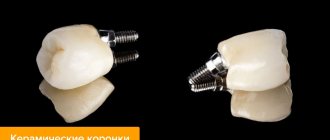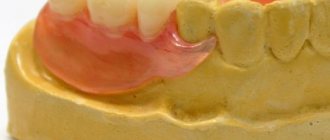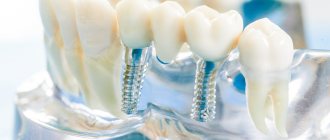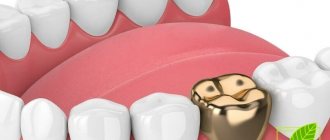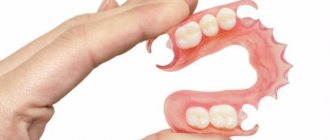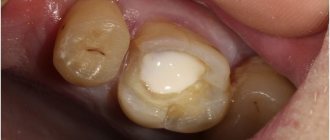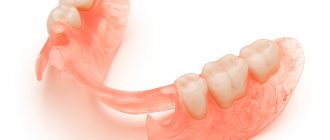Photos of upper teeth braces treatment
Normally, the upper incisors are located in front of the lower ones. But the other way around also happens, this is called reverse incisal overlap. This condition is non-physiological and non-functional, hence all the negative effects of reverse incisal overjet, including the negative impact on the aesthetics of the smile. This condition must be corrected when it is noticed.
In this case, one of the problems was complete reverse incisal overlap in the area of all anterior teeth. It was decided to begin treatment using a brace system, first on the upper row of teeth. There is still work ahead with the upper and lower dentition, but one of the main problems has been solved! The progress of treatment over 3 months pleases the patient, parents, and doctor!!!
Consult an orthodontist so you don’t miss the development of malocclusion in your child.
Preventive measures against caries
Any disease is easier to prevent than to treat, and caries is no exception in this regard.
To avoid its appearance, you need to:
- brush your teeth twice a day for 2 minutes;
- do not use toothpicks - special dental floss is more suitable for high-quality cleaning;
- use an irrigator or mouthwash;
- get rid of bad habits (smoking and drinking alcohol provoke deterioration of the oral cavity);
- eat more calcium in food;
- Get checked by a dentist at least once a year, but it’s better to do it more often.
| We must not forget that the main reason for the formation and development of caries is lack of hygiene. Therefore, prevention is extremely important, which consists of regular high-quality brushing of teeth after each meal. |
Photos of correcting crooked teeth in children
When milk teeth are removed early, the teeth behind them move forward, to the place of the removed ones, and occupy a “foreign” place. In this case, the primary canine was lost prematurely; its place was completely covered by the teeth behind it, thereby completely “taking” the place from the permanent canine. Fortunately, the orthodontist managed, with the help of a removable appliance, to move the entire segment posteriorly and get a place for the fang!) It didn’t take long to wait and soon erupted into the oral cavity! Of course, the work is not finished yet, but most of it is done!
How to treat caries: stages
To get rid of caries, you need to make an effort, because although modern drills do not vibrate like hammer drills, they still make us wait for the sudden appearance of acute pain - while drilling out carious tissues. Fortunately, modern anesthetics allow the dentist to properly numb the teeth during treatment - unlike the ineffective novocaine and lidocaine that were widely used previously.
Proper treatment of dental caries in dentistry consists of a number of successive stages, each of which has a clear goal. But nevertheless, the most important thing is the complete removal of caries, because... if the removal of tissue affected by caries is incomplete, it will immediately develop under the filling and will certainly lead to the development of pulpitis and the need to remove the nerve from the tooth. Watch the video below to see how hard tooth tissues affected by caries are removed.
Treatment of dental caries: video 1-2
In detail about the stages of treatment of average caries -
But before we move on to drilling out the carious tissue, which you could see in the video above, you still need to perform a number of procedures to prepare the tooth for treatment, as well as anesthetize it with an injection of a local anesthetic. For those who like stronger anesthesia, there are methods of sedation and general anesthesia.
- Cleaning a tooth from plaque (Fig.4) –
Before starting treatment, it is necessary to hygienically clean the tooth, as well as neighboring teeth, from plaque and tartar. For this purpose, ultrasonic attachments are used to remove massive dental plaque, as well as special brushes and abrasive pastes to remove soft microbial and pigmented plaque. - Determination of tooth color using a special scale (Fig.5) –
Hygienic treatment of the tooth also helps the doctor to accurately select the color of the filling material. In this case, the filling will match the color of the tooth, and will not stand out against the background of the tooth’s own tissues. This is especially important for teeth that are visible when you smile. - Anesthesia (Fig. 6) – is it painful to treat caries: for painless drilling of carious tissues if the tooth is alive, local anesthesia is necessary. Modern painkillers in dentistry, for example, ultracaine or ubistezin, make the intervention absolutely painless. Depending on the amount of anesthetic administered and the method of anesthesia, the anesthesia time can last from 40 minutes to several hours.
The only pain that the patient can feel is the moment the needle is inserted into the gum, as well as the process of removing the anesthetic into the tissue. This process can sometimes be painful, which largely depends on the patient’s level of pain sensitivity, as well as on the speed at which the anesthetic is injected into the soft gum tissue. The faster the solution is administered, the more painful the injection. - Drilling out carious tissues – As can be seen in Fig. 7, enamel is always destroyed with average caries to a lesser extent than the underlying tissue (dentin). This is due to the fact that enamel is much, much stronger and harder than dentin. Therefore, the carious cavity usually expands in depth, and the entrance hole in the enamel can even be quite small.
The dentist must drill out the edges of the enamel overhanging the carious cavity, and also remove all carious dentin. If you leave even a small amount of dentin affected by caries and put a filling on top of it, then very soon you can expect complications - the rapid development of caries under the filling and destruction of the tooth crown, with the subsequent development of pulpitis and periodontitis (24stoma.ru).
In Fig. 8, the dotted line shows the approximate boundaries of tooth tissue removal. In this way, the cavity is given a relatively correct shape and the next stages of treatment can begin. It should be noted here that recently new methods of tooth preparation have appeared, which help to do without traditional drilling. Recently, it has become possible to remove caries with a laser.
- Isolation of tooth from saliva – this is a very important stage! After the carious tissue is drilled out, and before filling the tooth, the doctor must carefully isolate the tooth from saliva and even the patient’s wet breath. These factors will greatly affect how long the filling will last. Previously, cotton balls and gauze balls were used for insulation, which were used to cover the tooth on all sides. It should be noted that this is a very unreliable and ineffective protection.
For the last 10 years, “cofferdam” has been used for these purposes. The latter is a thin latex “scarf” in which holes are made for the teeth. This scarf is pulled over the teeth (Fig. 9-10), after which 1-2 special metal clasps are installed on the necks of the teeth, which hold the rubber dam against the gums. The edges of such a latex scarf are attached to a special frame (Fig. 11), and we see the result - a group of teeth is completely isolated from the oral cavity.Installing a rubber dam is quite labor-intensive. Some doctors refuse to use it on principle to save their time. The doctor’s use of a rubber dam in the treatment of caries indicates that the doctor is very attentive to the quality of his work, because the quality of the filling will be affected not only by the accidental contact of saliva on the tooth being filled, but also simply by the moist breath of the patient himself.
- Medical treatment of a carious cavity - a cavity formed in the tooth during the removal of carious tissues - is treated with antiseptics.
- Restoring the contact point between teeth – If caries is treated on the contact (interdental) surface of the tooth, then it is also necessary to restore the side wall of the tooth.
This is a rather labor-intensive and complex task than simply treating average caries, for example, on the chewing surface of a tooth. In this case, another stage is added - the installation of special devices to restore the side wall of the tooth. Such devices include wedges (a) and matrix (b) in Fig. 12. Read more about the treatment of interdental caries in the article: → “Treatment of caries between teeth” - Etching the enamel with acid (Fig. 13) is necessary so that the adhesive (something like glue), which will be applied to the surface of dentin and enamel at the next stage, can penetrate deeply into the tooth tissue. For this purpose, a gel based on phosphoric acid is used. After etching, all the gel should be thoroughly washed off, and the tooth surface should be slightly dried.
- Treatment of dentin and enamel with adhesive - for better fixation of a permanent photopolymer filling, enamel and dentin are treated with a special adhesive, which (after absorption) is illuminated with a photopolymerization lamp.
- Applying a gasket under the filling (Fig. 14 b,c) - an insulating gasket, usually made of glass ionomer cement, is applied to the bottom of the cavity. The need for lining material under the filling is explained by the complex mechanisms of polymerization shrinkage of the filling material and other factors (we will not dwell on them).
- Filling – dental filling is necessary to restore the shape of the tooth, its aesthetics, as well as to restore chewing efficiency. For this purpose, photopolymer composite materials are usually used. They are applied in layers and each layer is illuminated with a special lamp, which allows the material to harden.
- Grinding and polishing of the tooth - after the shape of the tooth has been restored using filling material, it is necessary to grind and polish the filling, because it is rough and uneven. Final polishing gives the filling a shine and aesthetics comparable to that of tooth enamel. This completes the treatment of average caries.
→ Cost of treatment of dental caries
Filling a carious defect: video 3-4
Please note that dentists use special metal strips (matrices) and wedges to restore the side walls of teeth. In addition, tooth filling in both cases is carried out using a rubber dam.
Photos of installing braces before and after
If there is not enough space for the teeth, their crowded position is formed; the upper canines erupt later than all of them, when the space is already occupied by the rest of the teeth. As a rule, such teeth erupt outside and above the dentition, less often on the palatal side, and also do not erupt and remain in the bone. The average period for the eruption of fangs is up to 13 years, but it is better to focus on the sequence of teething; if all the permanent teeth have erupted, but the fangs have not, then this is a reason to consult an orthodontist.
Doctor: Tkalich Evgenia Aleksandrovna
Technical equipment
For fast shooting mode in high quality, the room is properly equipped:
- retractors;
- lamps with UV radiation;
- occlusal and lateral crystalline mirror;
- contrastor;
- cling film to protect the lens during operation.
The assistant is responsible for ensuring the operating condition of the equipment. The dentist is responsible for the quality of the images and settings. Proper distribution of responsibilities helps optimize the shooting process.
It is necessary to prepare the shooting location:
- choose a background (stage table or black matte fabric);
- prepare whatman paper and cardboard.
Lens, camera, macro flash
The clarity of the pictures depends on the quality of the digital camera. It is recommended to use a DSLR camera, which allows you to capture every detail when shooting.
European experts prefer the 70D technique. The camera is suitable for working in rooms with different levels of illumination and is capable of capturing an object from different angles without losing the quality of the images.
Characteristics of the flash for macro photography Canon Macro Ring MR-14EX:
- double lamps for brightness;
- LED bulbs;
- ring flash ensures even illumination;
- reliability and performance.
When choosing a lens, criteria such as quality, ease of use, functionality and affordability are taken into account. The listed characteristics are specific to the Canon EF 100mm f/2.8 USM Macro Lens Review.
Retractors, mirrors, contrastors
Full shooting is not possible without additional equipment.
Contrastors are specialized devices for creating a dark background. With their help, the shooting is focused on the part of the dentition of interest. The black background highlights imperfections. It is recommended to choose anodized aluminum products that are suitable for steam and high pressure sterilization. Treatment is carried out with a soap solution. Chemicals damage the black layer.
Mirrors – used for intraoral photography. Glass, 3 mm thick, is coated with platinoids. Reflects light effectively and is not prone to oxidation.
Mirrors are fragile and require careful handling. The product is processed and sterilized separately from other equipment.
A dental photograph requires at least two mirrors – a lateral and an occlusal one.
Retractors – provide visibility. Devices in the form of hooks, plates, etc. used to retract soft tissues and hold the mouth open. Due to its soft structure, it does not injure mucous membranes.
Shooting technique
Macro photography of the inside of the mouth is a challenging task. To implement it, you must comply with the following rules:
- shooting in manual mode without autofocus;
- installing a contrastor at a distance that prevents glare;
- heating the mirror with hot water before taking photographs to prevent fogging;
- the nose does not fit into the frame with the upper front teeth;
- the dental arch occupies the entire area of the image;
- saliva is removed and chewing surfaces are blown;
- The lighting turns on and the flash is removed.
Dental photography is the solution to dental problems.
And then there’s aesthetics
Aesthetic procedures include those that do not affect the functions of teeth, but simply make them attractive. Let's take a closer look at what you can do to improve the appearance of your teeth.
Artistic restoration
This includes masking small cracks, chips, and scratches in the enamel with filling material, if the tooth root is not damaged. Artistic restoration, or, as it is sometimes called, “extension,” is a good way to hide small defects for those who are satisfied with the natural color of the enamel. The color of the aesthetic filling is matched to the color of the remaining teeth, the filling looks natural. But it will no longer be possible to bleach it, so after such a restoration, bleaching is not recommended - the natural enamel will become lighter, and the filling may begin to stand out.
Whitening
If you like the shape of your teeth, there is no fluorosis or other stains on the enamel, but you want to lighten it, whitening is ideal. In a clinical setting, it is completely safe, since all drugs are certified, have been used for a long time and are well studied.
Whitening has virtually no risks; it is a simple and harmless procedure.
Installation of veneers
If the teeth are healthy, the bite is correct, but the patient does not like the natural shape of the teeth (for example, they are too small) or there are noticeable defects in the enamel, then installing veneers will be the solution.
The modern trend in installing veneers is a white, but natural shade and imitation of the texture of natural enamel, so that the teeth do not look “made.”
Veneers that are too white look unnatural
The size of the veneers is selected taking into account the individual characteristics of the patient’s appearance. By selecting the thickness of the plates, you can adjust the shape of the lips (veneers on the front incisors slightly raise the lips, but here it is important to observe the measure, otherwise the result will not be natural), and with the help of the form - the gum line.
There are generally accepted standards for the shape and proportions of veneers, but in each case the doctor selects them individually.
You can literally install from one piece, if this is justified, in order to hide some shortcomings. But the best results are obtained when veneers are installed over the entire smile area (10–12 teeth on top and the same number on the bottom).
Veneers are the best way to hide all dental imperfections
Consistently using all these technologies, anyone can get a perfect smile, regardless of the initial data.
